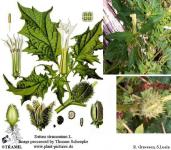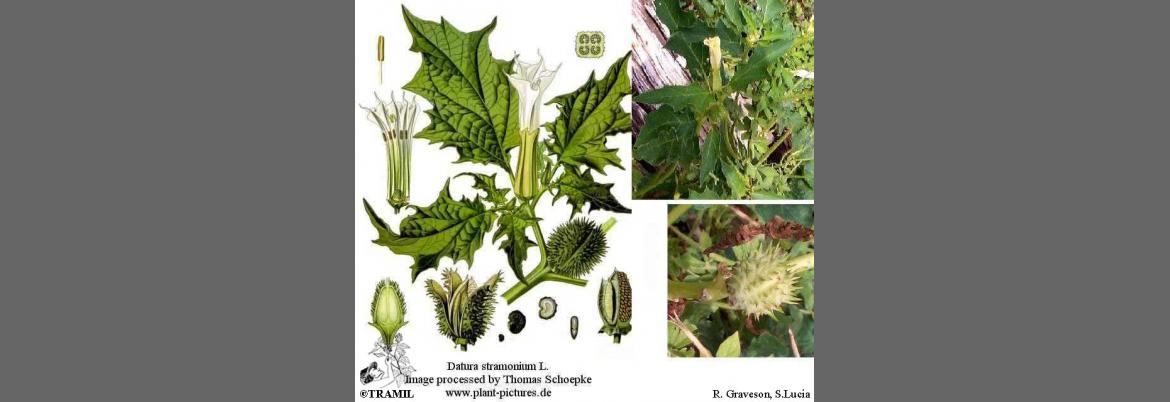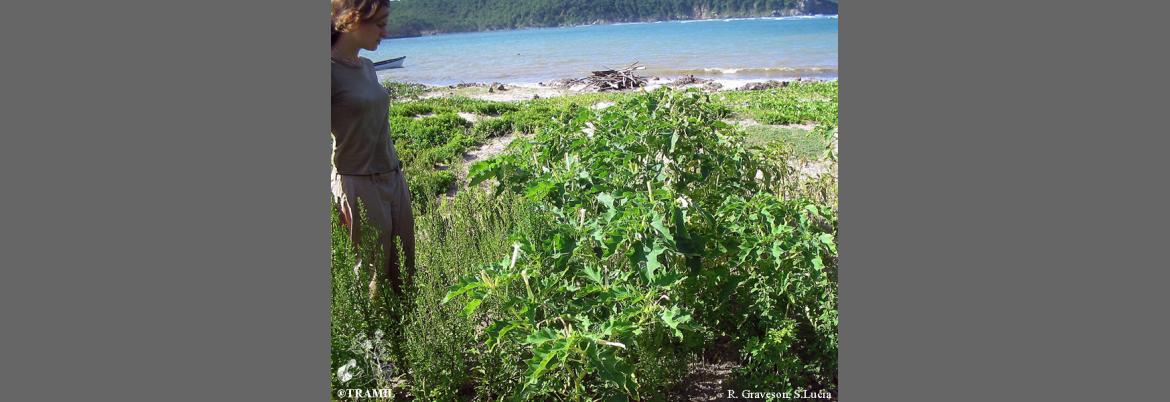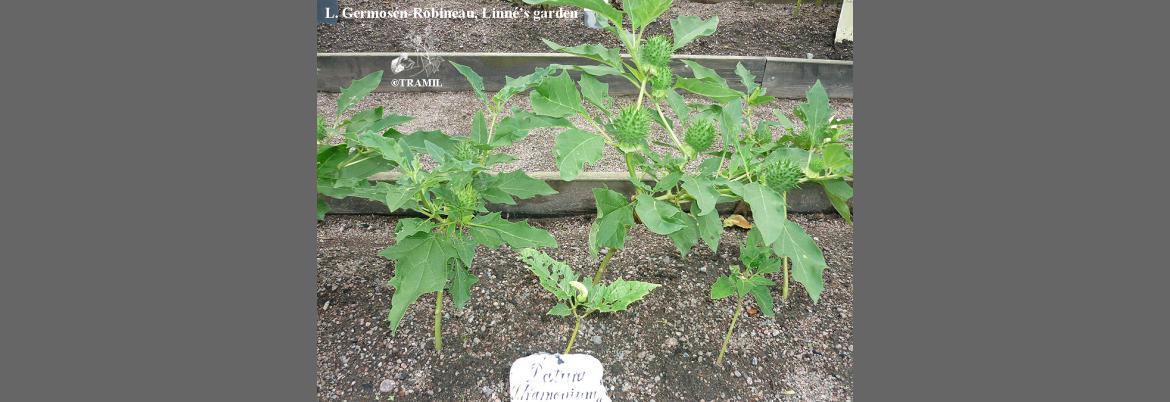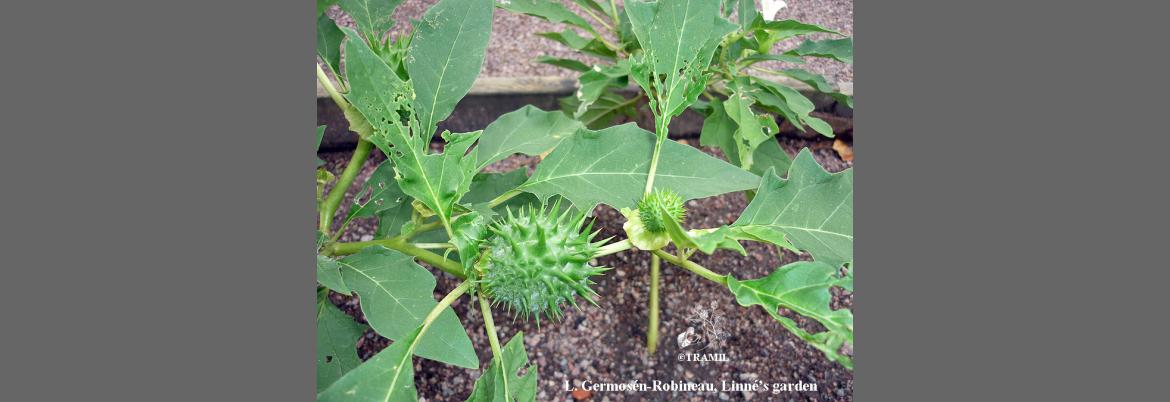1 WENIGER B, ROUZIER M, 1986 Enquête TRAMIL. Service Oecuménique d'Entraide SOE, Port au Prince, Haïti.
2 ALAMI RR, CHRISTENSEN BV, BEAL JL, 1955 A note on the alkaloidal ratios in certain species of Datura. J Am Pharm Assoc Sci Ed 44:710-711.
3 HEGNAUER R, 1973 Chemotaxonomy der Pflanzen. Basel, Schweiz: Birkhauser Verlag. 6:882.
4 SONANINI D, RZADKOWSKA-BODALSKA H, STEINEGGER E, 1970 Solanaceae flavones. 7. Flavonol glycosides from folium stramonii. Pharm Acta Helv 45(2):153-156.
5 TURSUNOVA R, MASLENNIKOVA V, ABUBAKIROV N, 1976 Withanolides of Datura stramonium. Khim Prir Soedin 12:670A.
6 PATE D, AVERETT J, 1986 Flavonoids of datura. Biochem Syst Eco 14(6):647-649.
7 SCHMITZ BOURGEOIS M, AMIRI I, REINBOLT J, BOULANGER Y, UNGERER A, 1988 Isolation and structure of a pseudopeptide gamma-L-glutamyl-L-aspartic acid fromDatura stramonium that impairs learning retention in mice. Biochimie 70(9):1179-1184.
8 PINKAS M, BEZANGER-BEAUQUESNE L, 1986 Les plantes dans la thérapeutique moderne. Paris, France: 2 éd. Ed. Maloine.
9 VINCENT D, LESOBRE R, KAUFMAN E, 1965 An antiasthmatic smoke as an anticholinergic and antihistamic effect. Therapie 20(4):931-952.
10 ITOKAWA H, MIHASHI S, WATANABE K, NATSUMOTO H, HAMANAKA T, 1983 Studies on the constituents of crude drugs having inhibitory activity against contraction of the ileum caused by histamine or barium chloride (1) screening test for the activity of commercially available crude drugs and the related plant materials. Shoyakugaku Zasshi 37(3):223-228.
11 FORNO JR FJ, TERRY RA 1998 Accidental ingestion of jimsonweed by an adolescent. J Am Osteopath Assoc 98(9):502-565.
12 UNGERER A, SCHMITZ-BOURGEOIS M, MELAN C, BOULANGER Y, REINBOLT J, AMIRI I, BARRY J, 1988 Gamma-L-glutamyl-L-aspartate induces specific deficits in long term memory and inhibits [3H]glutamate binding. Brain Res 446(2):205-211.
13 Hardman JG, Limbird LE, Molinoff PB, Eds., 1996 Goodman & Gilman las bases farmacológicas de la terapéutica. 9a ed. México: McGraw-Hill Interamericana: p158-163.
14 ZHANG J, 1990 Preliminary report on the serum level of pancreatic polypeptide in patients with chronic bronchitis and bronchial asthma during attacks. Chung Hua Chieh Ho Hu Hsi Tsa Chih 12(3):141-142.
15 KEELER RF, 1981 Absence of arthrogryposis in newborn Hampshire pigs from sows ingesting toxic levels of jimsonweed during gestation. Vet Hum Toxicol 23(6):413-415.
16 GOTO M, NOGUCHI T, WATANABE T, ISHIKAWA I, KOMATSU M, ARAMAKI Y, 1957 Uterus-contracting ingredients in plants. Takeda Kenkyusho Nempo 16:21.
17 HARVEY RB, LARSO AH, LANDON RH, BOYD WL, ERICKSON LC, 1945 Weeds poisonous to livestock. Bull Minnesota Agr Exp Sta 388:1.
18 FERNANDO R, FERNANDO DN, 1990 Poisoning with plants and mushrooms in Sri Lanka: a retrospective hospital based study. Vet Hum Toxicol 32(6):579-581.
19 BALLANTYNE A, LIPPIETT P, PARK J, 1976 Herbal cigarettes for kicks. Brit Med J 2:1539.
20 PEREIRA CAL, NISHIOKA SDA, 1994 Poisoning by the use of Datura leaves in a homemade toothpaste. J Toxicol Clin Toxicol 32(3):329-331.
21 GOWANLOCH JN, BROWN CA, 1943 Poisonous snakes, plants and black widow spider of Louisiana. New Orleans, USA: Dept. Conservation, Book.
22 HARRISON EA, MORGAN DH, 1976 Abuse of herbal cigarettes containing stramonium. Brit Med J 2:1195.
23 ODERDA GM, 1975 Jimson weed. J Am Med Assoc 232:597.
24 SCHMIDT A, 1943 Poisoning with stinging nettle tea. Pharm Zentralhalle Dtschl 84:238-239.
25 LAMENS D, DE HERT S, VERMEYEN K, 1994 Tea of thornapple leaves, a rare cause of atropine intoxication. Acta Anaesth Belg 45(2):55-57.
26 SIEGEL RK, 1976 Herbal intoxication. Psychoactive effects from herbal cigarettes, tea, and capsules. J Am Med Assoc 236(5):473-476.
27 GUHAROY SR, BARAJAS M, 1991 Atropine intoxication from the ingestion and smoking of jimson weed (Datura stramonium). Vet Hum Toxicol 33(6):588-589.
28 PARIS R, MOYSE H, 1981 Précis de matière médicale. Paris, France: Ed. Maloine.
29 CHONKEL A, 1985 A propos de quelques graines toxiques existant à la Guadeloupe (Thèse Pharmacie). Faculté de Pharmacie, Montpellier, France.
30 HARDIN J, ARENA J, 1974 Human poisoning from native and cultivated plants. 2nd ed. Durham, USA: Duke University Press.
31 TAH S, MAHDI A, 1984 Datura intoxication in Riyadh. Soc Trop Med Hyg 78(1):134-135.
32 PARRA AL, YHEBRA RS, SARDINAS IG, BUELA LI, 2001 Comparative study of the assay of Artemia salina L. and the estimate of the medium lethal dose (LD50 value) in mice, to determine oral acute toxicity of plant extracts. Phytomedicine 8(5):395-400.
